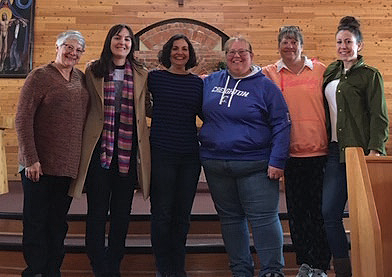
Mentoring:
An Act of Service
By Emily Rust
Welsh Academy student Victor Perez and his Saint Ignatius Big Brother Anthony Jenkins, class of ’21
When coming up with a name for a mentorship program, Marquette University looked to the history of the Society of Jesus for inspiration.
“We thought about St. Ignatius of Loyola and his companions on his journey,” Jacki Black, director for Hispanic initiatives and diversity and inclusion programming at Marquette, says. “There wasn’t one person leading. They were walking alongside each other.”
They named the program Encuentros, meaning “encounters,” to emphasize the value of building relationships for both the mentor and mentee. Encuentros pairs Marquette students with Cristo Rey Jesuit High School Milwaukee students.
It’s this peer-to-peer interaction that inspired Jose Vazquez Rojas to work hard when he was a student at Cristo Rey.
“It gave me a lot of hope that if this student with a similar background is able to make it, then I can too,” he says.
Now a junior at Marquette, Vazquez Rojas is giving back to his high school by serving as an Encuentros mentor. The program looks to connect first-generation college students with Cristo Rey students to offer guidance and support during the daunting college application process.
ONCE YOU EXPERIENCE AND MEET THE PEOPLE, YOU SEE THE MISSION WORKED OUT . . . YOU SEE CURA PERSONALIS
“Having someone who recently has gone through it themselves, giving advice, guidance, and support, saying this is my experience with it . . . all those things can help increase a student’s confidence,” Black says.
Zuleyka Rios, director of postgraduate success at Cristo Rey, says that Encuentros is “more personal” for the high school students, especially as many students on the Marquette side are Cristo Rey alumni. Additionally, the shared Jesuit ideals lend to an elevated mentorship.
“They’re motivated by service and love,” Rios says. “Mentors have that specific piece of the Jesuit mission and values.” Ignatian charisms, such as the practice of reflection, are embraced by the mentoring program between Creighton University and Red Cloud Indian School on the Pine Ridge Indian Reservation in South Dakota.
Creighton faculty and staff travel to Pine Ridge to learn about the Lakota culture and history and to reflect on the influence it has on Red Cloud students today. They visit the Wounded Knee Massacre site, the Crazy Horse Memorial, Custer State Park, and other sites important to Lakota culture.
“Once you experience and meet the people, you see the mission worked out . . . you see cura personalis,” associate professor of pharmacy practice Jenny Tilleman, Pharm.D, says.
Creighton University faculty mentors visit the Pine Ridge Indian Reservation.
From left: Jodi Kava, Abbey Berkebile, Laurie Galeski, Jenny Tilleman, Kathleen Denne, and Lucy Hancock
While there, the Creighton cohort helps Red Cloud students with their college application essays. Tilleman says the students often have trouble talking about themselves, so the mentors ask questions to draw out their stories, allowing the students to make their essays more personal.
“It gives the students confidence that they are important. People really do want to hear their stories,” says Tilleman.
For the Creighton mentors, the experience demonstrates the greater Jesuit mission in a different setting.
“For some people, it’s a very emotional and spiritual exercise,” Tilleman says. “They learn about people in different socioeconomic statuses, and they’re getting out of their comfort zone.”
The program also helps establish relationships for Red Cloud students who later attend Creighton, such as a former mentee of Tilleman’s who felt more comfortable attending the university knowing she had a mentor there.
“I know it’s one of the struggles of many students when they leave the reservations,” Tilleman says. “To have [a support system] built in already is helpful.”
In Cleveland, students at The Welsh Academy don’t need to travel far to visit their mentors, as they’re on the same campus as Saint Ignatius High School. Sixth grade Welsh students are paired with senior Saint Ignatius students in the Big Brother program.
“We knew because of our guiding principles, that we wanted the middle school boys to have a good experience with the high school students,” Welsh founding principal Mary Ann Vogel, Ed.D., says. “The Welsh Big Brother program was one of the best ways to do that.”
The program started in 2019, with each Welsh student being assigned a big brother. With their mentors, Welsh students would attend a class at the high school, celebrate Christmas and the Mass of the Holy Spirit, and attend football games.
With the onset of the COVID-19 pandemic, the program evolved into a different dynamic with sixth graders getting to know a group of big brothers rather than just one student. The big brothers help Welsh students form “an idea of the high school student they can be,” Vogel says.
Groups are paired with similar affinities like a shared sport. It builds bridges across the two schools and helps a nervous sixth grade Welsh student feel a sense of belonging on campus.
“To be able to watch older boys working with the younger boys . . . it fills your soul,” Vogel says. “You know they are helping them in a way that is so different from what a teacher does . . . they talk the same talk.”




